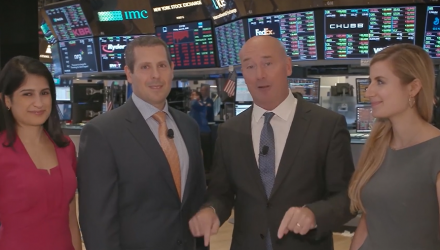“It’s been a great year on net cash flow for anyone who’s launching ETFs or has a business where they’re generating assets as well as on the trading side,” said Yones.
![]()
 Fixed-Income Growth
Fixed-Income Growth
The adoption of ETFs for various uses has spurred areas of growth where investors are now able to corner certain aspects of the capital markets that where not readily available before. One of those is the fixed-income space where investors can obtain bond exposure and diversification without having to invest directly in the debt itself, almost creating a new class of bond investors that can thrive in various economic scenarios.
“It’s these fixed-income ETFs that continue to be launched with new ways to access that market wrapped in an ETF wrapper,” said Yones.
Forthcoming Industry Changes
With ETFs growing at a rampant pace, innovation has been a byproduct and companies are finding new ways to accommodate the growth in this space, especially from a regulatory standpoint.
“In my 20 years in the ETF industry, I can’t really think of a more dynamic regulatory environment than right now,” said Yones.
At the New York Stock Exchange, the focus is on more transparency and expediency, such as the publishing of closing prices. The NYSE is using mathematical algorithms so that investor and issuers know the exact price of an ETF at a specific time.
“We began a whole new process where now at the New York Stock Exchange, if your ETF is listed here, we run this great calculation where we take the mid-point of the bid and the offer,” said Yones. “It’s somewhat scientific, but it’s a smarter way to value these ETFs.”
Yones cites specific areas of the market that ETFs are trending towards, such as artificial intelligence, robotics and other disruptive innovations that are in the forefront of what could be a vastly different ETF scenario than in days past.
“Those are all new categories of investing that maybe don’t fit into a pure technology ETF where now you can capture the growth of those companies in a brand new ETF,” said Yones.
Smart Beta: The Intelligent Choice
Earlier this month, the United States capital markets witnessed exactly how vulnerable it can be to geopolitical risk with the markets roiled by the economic crisis in Turkey and how quickly it turned around with news breaking on renewed trade talks between the U.S. and China.
While this might spook the most risk-averse investors, Dahiya reminded investors that volatility can also serve as an ally in equities and adaptability can help in bond markets.
With the U.S. equities market full steam ahead along with trade concerns, particularly between the United States and China, it’s provided an ideal habitat for volatility. With that volatility comes a break from the tradition of market cap-weighted investments in which portfolios are constructed based on the market capitalization sizes of various stocks.
“One of the interesting changes that we’ve seen this year with the increase in volatility is an interest or a growing interest in smart beta or as we call it, strategic beta products,” said Dahya. “But essentially products that do something different than market-cap weighted and I think that trend is growing because of the more recent volatility.”
By employing a smart beta strategy, it can actually help investors mute volatility without being heavily exposed to certain stocks based on their market capitalization sizes, which can be prone to large swings during frenzied markets. This also serves as an effective diversification tool rather than heavy concentration to a specific sector.
“Market cap-weighting by nature of the way it works is subject to concentrations of risk,” added Dahya. “So if you think about the S&P 500, 150 stocks make up three-quarters of your exposure so you actually have a lot of exposure to a small part of the market. There is an opportunity to diversify that risk, which helps to lower volatility.”
Adaptable Fixed-Income ETF
For the fixed-income investor, Dahya suggests looking at the JPMorgan Ultra-Short Income ETF (JPST), which can serve as a flexible tool during times when rates are decreasing or rising. The floating rate component of bonds in JPST’s debt portfolio would effectively hedge against interest rate risk and capitalize on any short-term rate adjustments the Fed decides to make through the rest of 2018 and beyond.

Related: In the Know – Stay up to date on ETF This Quarter
Furthermore, the fund seeks to maintain a duration of one year or less, thereby limiting prolonged exposure to the fluxes of the capital markets and reducing volatility. This is effective for investors who want to avert the risk associated with holding on to debt securities with long durations.
“We are seeing a lot of interest in our short-term fixed-income product and it’s coming from two dimensions,” said Dahya. “From on dimension, it’s clients who, because of low interest rate, are looking to come up the yield curve to add additional yield to their portfolio, but there’s also clients who are thinking about rising rates and their implications on their portfolio, are looking to come down the yield curve and lower their duration.”
Alternative Strategies
An area that Dahya sees as one that is rife for innovation is within alternatives strategies funds. By utilizing the same methodologies employed by hedge funds, alternative strategies funds can benefit, particularly in a down market.
“In that market context, I think there’s a lot of value for an alternative,” said Dahya. “The challenge has been for clients that historically, alternatives have been very expensive and in many cases, have not been accessible to a lot of clients.”
